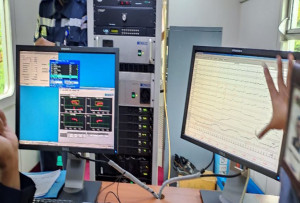Facility Maintenance, Trial of Ciremai Train Measuring Instruments

Grobogan – Maintenance of railway facilities is not only in checking the condition of machines and components of the means of propulsion. In certain facilities, maintenance is also carried out on special tools installed on the facilities. These types of facilities generally have a special function, not only as a means of transportation.
The Railway Maintenance Center manages the maintenance of various railway facilities with these special functions. Some of them are Multi Tie Tamper, Fudika Train, Telescopic Railways Crane and Ukur Train. Especially for the last-mentioned carriage has a special measuring tool that is embedded and attached to the body of the facility.
The measuring instrument on the Gauge Train is used in the maintenance of railway infrastructure. The measuring train itself functions to scan (know and measure) the condition of the railroad track and Overflow Electricity (LAA). Checking the rail road and LAA is part of the maintenance of vital infrastructure. Railroad and LAA conditions that are not up to standard can threaten the safety of rail transportation.
As a technical service unit engaged in the maintenance of railway facilities and infrastructure, the Railway Maintenance Center is tasked with maintaining railway facilities, including facilities that have a function in the maintenance of railway infrastructure. This task is carried out as part of efforts to maintain the safety of rail transportation.
Such as the activities carried out by the Railway Maintenance Center team on the agenda for testing the measuring instrument for the Ciremai Measuring Train on Tuesday (15/3/2022). The Ciremai Ukur Carriage itself is one of the state-owned facilities currently located in the stabling area of the Ngrombo Workshop.
An important part of the Measuring Train is in the Track Geomerty Measurement System (TGMS) measuring system device installed in the train. The unit consists of several parts. Among them is the measuring beam device (TGMS beam) which is installed near the train wheels with the function of scanning rail track objects. In addition, there are computer devices to receive data, along with a computing system for reading data.
The pilot activity was monitored directly by the Directorate of Facilities, Directorate General of Railways, who was also present at the said agenda. Activities can be carried out by involving synergies between stakeholders in the railway sector. The Railway Maintenance Center cooperates with PT INKA (Persero) and PT IMSS as manufacturing and maintenance facilities, then involves PT KAI (Persero) as the operator who manages the railway line that the train will pass during the test.
The rail road that became the test route was the round trip route from Ngrombo Station - Gundih Station. The route starts from the starting point of Ngombo Station to Gundih Station by passing Gambringan Station, then returns and ends at the starting point of Ngombo Station.
There are at least five officers who are directly involved in the testing process outside the machinist and supervisor. In the process of testing the measuring instrument, the team performed each task in parallel. There are officers who operate the FOCC tool for setting up and down pegs, as well as marking the cross-sections that trains pass, such as money orders, bridges, platforms, and others. Meanwhile, other officers operate a computer system to transmit data obtained from measuring instruments.
Testing of measuring instruments on rail roads is carried out along the test route for several parameters, including distance between rails, vertical unevenness, horizontal unevenness, cross-level differences at a certain distance, and height differences between right and left rails, as well as rail profiles to measure rail wear.
Rail condition data is obtained from sensors installed in the measurement beam. The device is equipped with a laser that is useful for capturing the width of the track accurately. The data from the measuring bar will be compared with the data from the FOOC tool. The data is inputted into the TGMS computer device, which is then read by the system and produces output in the form of graphical data on changes in the cross-section of the rail line along the test track being passed.
The graphic data will provide information on how the performance of the measuring tools in the Ciremai Measurement Carriage is. During field observations, the journey of the measuring train and the measurement process on the specified route ran smoothly, safely and under control.
No problems were encountered during the trial process. Before entering the test route route, the team made preparations in the Ngrombo Workshop area first, to ensure that there were no potential problems that arise when on the highway. Preparation includes checking the control instrument by reading the master bar to the specified standard. Then conduct a road test experiment on a curved rail line in the Ngrombo Workshop area to read the tachometer and curvature with the results according to the parameters.
Maintenance activities for railway facilities with similar methods are carried out according to the needs of the facilities. Testing of facilities on highways is not only to test the equipment on the facility, but also to test the performance of the facility itself, including braking performance, engine acceleration and deceleration performance, and comfort in the facility.
The trial agenda for the Ciremai Measurement Carriage was carried out for approximately two hours. The train starts running from Ngrombo Station at 11.00 and returns again at the same point after crossing the route from Gundih Station at 13.00. (yogo)



.jpg)

Komentar
LOGIN FOR COMMENT Sign in with Google